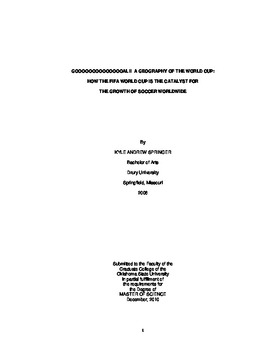| dc.description.abstract | The purpose of this study was to geographically analyze the growth and diffusion of the FIFA World Cup. The overall hope was to establish that the World Cup is the catalyst for the growth of soccer worldwide. By compiling and mapping data from the initial World Cup in 1930 through the 2010 edition, it would then be possible to visualize the growth of soccer over the years. The World Cup occurs every four years and the data was organized and mapped with every tournament cycle. Thus, chronologically, it can be determined that the World Cup grows and spreads from the cultural hearths of soccer, Europe and South America, into new areas, Africa, Asia, and North America. Prior to the study, a secondary hypothesis was made, suggesting there are two distinct eras of the World Cup: an embryonic period from 1930-1962, and a modern period from 1966-2010. The World Cup started in 1930 with 13 teams being invited to play. As the years passed, the tournament became more popular. Technological innovations allowed for decreased travel time and faster news distribution. The World Cup became increasingly popular amongst fans and nations. In 1966, the World Cup entered the modern era with advertising, sponsors, mascots, and most importantly, more nations would be involved from there on out. The World Cup began as primarily a European and Latin American tournament, however, in the modern era, teams qualified from all over the world. In the 2010 tournament, there represented 32 teams from six continents, a major change from the embryonic period. Television has also made a tremendous impact. The 2006 World Cup Final was viewed by 715 million people globally. Based on the expansive growth that FIFA membership and the World Cup has seen over the years, it is accurate to say the World Cup is the catalyst for the growth of soccer worldwide. | |
